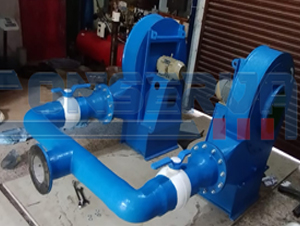DEGASSER TOWER
These degasser towers can be used if H2S or CO2 levels are high in RO & DM plant treated water. Degasser tower works with forced draft principle with the vertical tower. Basically, Reverse Osmosis is often followed by “Degasification” to remove the remaining dissolved gases such as Hydrogen Sulfide (H2S) or Carbon Dioxide (CO2).
Conserva Composite Degasser Tower can be effectively removed from the water when utilizing a “Degasification or Decarbonation System”. A properly designed decarbonator will remove CO2 levels to as low as 99.99%. A well-engineered and manufactured “Degasification” tower can remove H2S also to 99.99% or BDL. There are certainly other variables that play a role in the removal efficiency of both a decarbonator and degasifier. These variables include items such as the total inlet water flow rate, the inlet feed temperature of the water, the ambient air temperature, and the inlet concentrations that can be expressed as parts per billion (ppb), parts per million (ppm), or Mg/l, and the desired effluent removal levels also expressed in the same method. It is also important to fully understand the actual application and the use of the water to determine how critical maintaining critical levels are and what impact variations will create for the final use. Understanding these variables will aid you in the design of the system and any additional redundant systems needed to assure full compliance with standards.
Degasification is utilized to remove the free dissolved (H2S) and (CO2) gas that remains in the permeate water prior to either additional treatment such as ion exchange or pre-chlorination. Removing H2S before the addition of chlorine reduces the amount of chlorine required to achieve the necessary residual levels while also improving the water quality by lowering the TSS. This improves the clarity of the water. The Degasification process is also used to remove (CO2) to raise the pH without the need for additional chemicals such as caustic which reduces the cost of operating the treatment process. Membrane filtration only removes solids from the water so any free form of gas or residual solid that is converting into a gas will still be present and can cause damage downstream from its corrosive nature and will raise operating costs.
Degasser Tower are similar in nature and are designed for Carbon Dioxide (CO2) removal from the incoming water. A properly designed decarbonator can remove 99.99% of the free carbon dioxide gas that is present in the water stream. One of the primary reasons for utilizing a decarbonator or degasifier for the removal of carbon dioxide gas is the raise the pH of the water without the need to add acid / alkali dosing resulting in high-purity water
APPLICATIONS:
- Bore Well Water
- DM Plant
- Caustic
- Drinking Water
- Food Processing
- RO Plant
- Textile Dyeing process
ACCESSORIES:
- Blower
- Common Skid
- Duct & Fittings
- Fasteners
- Gasket
- Glass Tube Level Indicator
- Handrail
- Ladder
- Level Sensor
- Motor
- Starter Panel Board
- Valve & Fittings
MATERIALS OF CONSTRUCTION:
1. We have Used THERMOSET Materials:
(i). Resins:
- Isophthalic Polyester Resin
- Bisphenol
- Vinyl Estre
- Super Vinyl Estre
- Epoxy Based Vinyl Ester
- Epoxy Resin
(ii). Additives:
- Catalyst
- Accelerator
- Promoter
- Pigmentr
2. We have Used THERMOPLASTIC Materials:
- PP- Polypropylene
- PPH - Polypropylene Homopolymer
- PPRC- Polypropylene Random Copolymer
- PVC - Polyvinyl Chloride
- CPVC - Chlorinated Polyvinyl Chloride
- UPVC -UnplasticizedPolyvinyl Chloride
- HDPE - High Density Polyethylene
- LDPE - Low Density Polyethylene
3. We have Used Reinforcement (Fibre Glass Mat):
- Chopped Strand Mat (CSM)
- Woven Roving Mat (WRM)
- Surface Mat (SM)
TANK DESIGNS:
Shell:
- V – Vertical
- H – Horizontal
- C – Cylindrical
- R – Rectangular
Top:
- OT – open top
- CT – conical top
- DT – dished top
- FT – flat top
Bottom:
- FB – flat bottom
- DB – dished bottom
- CB – conical bottom
- SB – sloped bottom



